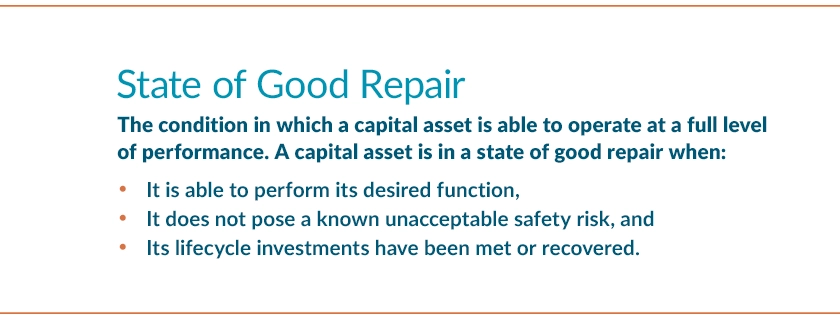How Decision Analytics Can Help Transit Agencies Reduce State of Good Repair Backlog
Tens of millions of Americans depend on the safety, affordability, and reliability of the public transportation system. But America’s transit system is facing a historic challenge.
The American Society of Civil Engineers (ASCE) 2021 report gave the public transit system a grade of D-, noting that over a 10-year period, almost 20% of the country’s transit vehicles and 6% of fixed guideway elements like tracks and tunnels were in poor condition. Estimates of the current backlog in maintenance and repair spending across the transit system vary by source, but all exceed $100 billion, with the ASCE estimating this deficit will grow to more than $270 billion through 2029.
Raising the bar on transit asset management
The U.S. Department of Transportation Federal Transit Administration (FTA) implemented a Transit Asset Management (TAM) Program to support transit agencies in tackling this growing backlog and achieving and maintaining a State of Good Repair (SGR) for all assets.
 Source: FTA Transit Asset Management Final Rule Fact Sheet
Source: FTA Transit Asset Management Final Rule Fact Sheet
In the TAM Final Rule published in 2016, the FTA required all publicly funded transit agencies to have a fully compliant transit asset management plan in place to help prioritize funding based on asset condition and performance. The TAM plan must include “a description of analytical processes or decision-support tools used to estimate and prioritize capital investment needs over time, and a project-based prioritization of investments.”
In response, transit agencies across the US have worked to incorporate compliant asset management practices, developing in-house tracking tools, and/or incorporating solutions like the FTA-developed, free-to-use TERM Lite asset management tool.
Navigating complex operating conditions
For transit agencies, deciding when and where to distribute limited funds to achieve SGR over an asset base of hundreds to hundreds of thousands is a challenging task. In a perfect world, assets would degrade on a linear, predictable basis, repair and replacement parts would be readily available when required, and consumer demand and environmental conditions would be stable.
But we aren’t living in a perfect world.
Since the TAM Final Rule was published and TERM Lite was first released, transit agencies have had to navigate unprecedented times. During the COVID pandemic, transit demand dropped dramatically—with ridership reaching a low point of 20-40% of pre-pandemic levels in many cities—and supply chain issues have affected the entire transportation industry. On top of this, the US has suffered more than 140 billion-dollar extreme weather and climate disasters since 2016.
Tackling the SGR backlog with decision analytics
Decision support tools can help transit agencies navigate these dynamic conditions and ensure day-to-day decisions are moving the needle on the SGR backlog.
Copperleaf’s Decision Analytics Solution expands on the capabilities provided in TERM Lite, providing transit agencies with a robust, centralized solution to manage hundreds of thousands of assets and accurately estimate and prioritize capital investment needs over time.
Using Copperleaf®, transit agencies can ensure spending decisions are aligned with both FTA requirements and regional priorities, from service availability and customer satisfaction to risk mitigation and sustainability goals. “What-if” scenarios can easily be developed to compare and contrast the value, timing, risks, and costs of different investment strategies, leading to more consistent, transparent, and defensible decision-making processes.
Planners can use geospatial and socioeconomic data to analyze plans and ensure equitable distribution of investments to disadvantaged communities—providing the insights and visibility required to meet the Justice40 goal of demonstrating that 40% of benefits from Federal grants, programs and initiatives are flowing to those who need it most.
And when circumstances change, Copperleaf’s powerful analytics engine provides the ability to re-optimize multi-year plans under new targets and constraints, reducing a task that can require weeks of effort to a matter of hours.
Managing risk and maximizing value
For over twenty years, critical infrastructure leaders around the globe have relied on Copperleaf to help them transform their Asset Investment Planning (AIP) processes and develop optimal sustainment strategies to manage risk, meet performance targets, and maximize value.
To learn more about how your organization can leverage Copperleaf to optimize AIP and tackle the SGR backlog, feel free to reach out to me directly or connect with our team at the Transit State of Good Repair Conference in Washington in March.

